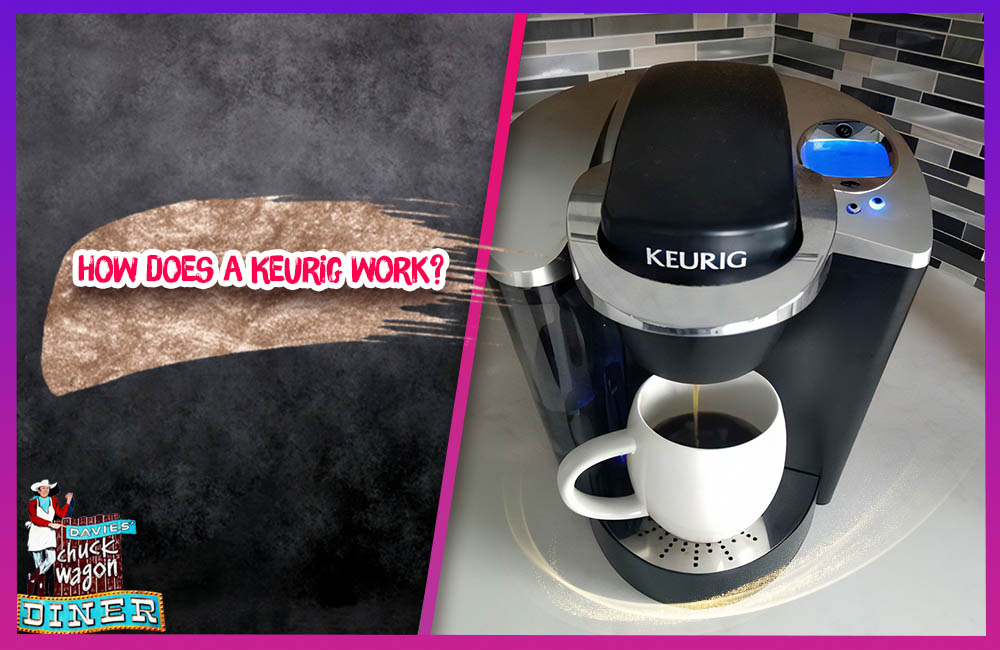How does a Keurig work? Do you ever wonder what’s really going on when you put a K-Cup into your Keurig and the steaming cup of coffee emerges? As it turns out, there’s actually quite a bit happening under the hood with each press of the brew button!
By examining how Keurigs work, we can gain an appreciation for all their incredible features that make brewing a cup of coffee easier than ever before. From understanding the design of K-Cups to learning about patented technology like Pressure Actuation and Automatic Brewing Control, let’s explore this modern marvel roast by roast.
What is a Keurig?
Table of Contents
A Keurig is an automated coffee maker designed to be used with special K-Cup® portions of ground coffee, tea or hot cocoa. It brews single servings of fresh-tasting beverages in a matter of seconds, making it a great choice for busy households.
History about Keurig Coffee Makers
Keurig coffee makers have revolutionized the way people make coffee. The concept was originally developed in 1998 by John Sylvan and Peter Dragone, who wanted to make it easier to brew great-tasting coffee in a single cup. Their first model, the K-Cup® brewing system, used pre-packaged portions of ground coffee sealed in individual plastic cups.
How does a Keurig work?
1. Start by filling the water reservoir with cold filtered water.
2. Place a K-Cup® portion pack in the brewing chamber and close the lid to secure it in place.
3. Select your desired cup size and brew strength, then press the “brew” button to begin making your beverage.
4. The machine will heat the water and force it through the K-Cup® at high pressure to extract all of its flavor and aroma.
5. When the brewing process is complete, remove the used K-Cup® from the chamber, dispose of it and replace with a new one for your next beverage.
6. After use, you can run a hot water rinse cycle through your machine to remove any leftover grounds.
7. Finally, empty the water reservoir and wipe down with a clean cloth for easy cleaning and maintenance.
This process makes it possible to enjoy fresh, hot coffee within seconds at the press of a button! From bold espresso drinks to specialty teas and cocoa, Keurig machines make it easier than ever for everyone to enjoy their favorite beverages.
Read more:
Can you lose weight with Enzyme Coffee?
Are apples stronger than coffee ?
Does Coffee Contain Sulfites?
Tea and Coffee Mixed – Curiously Interesting Facts
Is Coffee Good for Sore Throats
How K-Cups Work?
K-Cup® portions are individual plastic containers of pre-ground coffee, tea, or hot cocoa. These containers feature a perforated top that allows for water to be injected into them when inserted into the Keurig’s receptacle. The filtered hot water is forced under pressure through the K-Cup®, extracting oils and flavor from the coffee grounds and producing a fresh, hot beverage.
The K-Cup® portions are designed to keep out air, light, and moisture which preserves the quality of the coffee for up to 12 months. This makes it easy to store large quantities of K-Cups® for future use without having to worry about their freshness.
Pros and cons of Keurig Coffee Makers

10 pros of Keurig
1. Quick and easy to use – no need to measure coffee or wait for a pot of coffee to brew
2. Ability to customize beverage size and strength
3. Variety of flavors and types available, including tea and hot cocoa
4. Affordable compared to buying pre-packaged drinks from the store
5. Environmentally friendly K-Cup® containers are recyclable
6. Easy maintenance with self-cleaning features
7. Small and compact – great for tight spaces
8. Portable – can be used anywhere there’s an outlet
9. Durable construction ensures long lasting performance
10. Convenient way of making single servings of fresh hot beverages at home or in the office
10 Cons of Keurig
1. High upfront cost compared to traditional drip coffee makers
2. K-Cups® can be expensive if not purchased in bulk
3. Limited options for customizable beverage sizes and strength settings
4. Disposable K-cups create additional waste
5. Not ideal for large groups of people, as you have to make each cup individually
6. Can be slow to warm up if used frequently
7. Some grounds may escape into the cup, which can affect taste and texture of coffee
8. Generally not capable of making cold beverages like iced coffee or tea
9. May require additional filters and accessories to brew coffee or tea the way you like it
10. Can be loud when in use and may produce a lot of steam.
Overall, Keurig coffee makers offer convenience and a variety of flavors at an affordable price. However, they may not be ideal for large numbers of people due to their single-cup capability, and their additional accessories can make them more expensive than traditional drip coffee makers. With proper maintenance and care, however, a Keurig will provide years of great-tasting beverages for your household.
How to Clean Keurig
Maintaining a Keurig machine is essential to get the best performance and flavor from your beverages. Most models feature self-cleaning functions that can be used periodically for general cleaning, but for deeper cleanings it’s necessary to disassemble parts of the machine. To clean your Keurig coffee maker, you’ll need some vinegar, water, a soft cloth, and a sponge.
1. Start by turning off your machine and unplugging it from the power source. Then remove the K-Cup® receptacle and the drip tray (including any used K-Cups®).
2. Prepare a solution of one part vinegar to two parts water in a bowl or cup.
3. Dip a soft cloth into the solution and use it to wipe down the exterior of the Keurig machine.
4. Clean out any leftover coffee grounds in the portafilter with a sponge or brush if necessary before wiping it down with your cloth as well.
5. Fill up the reservoir with fresh cold water and add a few drops of the vinegar solution.
6. Place a large container (at least 32oz) under the Keurig’s portafilter, then place a K-Cup® into the receptacle with no coffee grounds in it.
7. Select the 8 oz cup size on your machine and pass several cycles of water through without making any coffee until you’ve emptied out the reservoir.
8. Empty out the bowl or cup used to collect wastewater and rinse it with clean water before reassembling your machine.
9. Refill your reservoir with fresh cold water and run several more cycles to rinse out any remaining vinegar residue before using again as normal. By following these simple steps, you can ensure that your Keurig coffee maker is properly cleaned and maintained to provide years of great-tasting beverages.
Tips to maintain Keurig
1. For even better tasting coffee, clean the machine at least once a month or more depending on usage.
2. Descaling solutions can be used instead of vinegar for a more thorough cleaning, although these may vary from model to model so make sure you check the owner’s manual first before using any specialized descaling solutions.
3. Replace water filters regularly as recommended by the manufacturer to maintain optimal performance and quality of your beverage.
4. To prevent limescale buildup from occurring, use filtered water when filling up the reservoir and avoid using hard tap water for best results.
5. Never use soap when cleaning your machine as this can damage the interior components.
6. Don’t insert anything into the K-Cup® port apart from K-Cups®, reusable filters, and descaling solutions.
7. Always store K-Cups® in a cool dry place to keep them fresh for longer.
8. When storing your Keurig coffee maker, make sure it is disconnected from any power sources and that all removable parts are cleaned and dried before replacing them properly so they don’t get damaged or moldy over time.
How to troubleshooting Keurig
If your “Descale” light is illuminated on the Keurig machine, it means that the machine needs to be descaled. Descaling helps remove calcium deposits which can build up overtime and affect the performance of your brewer. To descale, you will need a special descaling solution (which may vary depending on the model) or white vinegar.
1. Unplug your machine from any power sources, then fill up the reservoir with fresh cold water.
2. Add either 1/2 liter of the specialized descaling solution or 4 cups of white vinegar into the reservoir and stir gently until mixed in evenly.
3. Place a large bowl or cup underneath the portafilter before placing a K-Cup® into the receptacle and selecting the 8 oz cup size.
4. Pass several cycles of water through until the reservoir is empty, then discard any wastewater collected in the bowl or cup.
5. Refill your reservoir with fresh cold water and run several more cycles to rinse out any remaining descaling solution before using again as normal.
6. After descaling, select “Brew” on your machine and make sure no water comes out from the portafilter during this time as it may indicate that there are still some leftover sediments that need to be cleaned out first.
7. Once all sediments have been removed, you can continue using your Keurig coffee maker normally again as the “Descale” light should now be turned off.
8. If the “Descale” light is still illuminated, repeat the steps above until it goes off.
9. For best results, descaling should be done every 3 months or so depending on usage to keep your machine running in optimal condition for years to come.
With proper maintenance and care, your Keurig coffee maker can provide years of delicious hot beverages for you to enjoy.
Difference Between a Drip Brewer and a Keurig
A drip brewer is a popular coffee machine that uses ground coffee beans and hot water to brew fresh cups of coffee. It works by dripping hot water through the grounds into a carafe or cup located underneath it. The process is slow but produces a consistently flavorful cup of coffee with every batch.
The Keurig, on the other hand, is an advanced single-cup system which eliminates the need for a carafe or any additional equipment when brewing one cup of coffee at a time. Instead of using grounds, it utilizes K-Cups® (or another type of pod) filled with pre-ground and pre-measured amounts of freshly roasted beans to quickly make hot delicious beverages in minutes. While this method lacks some control over the flavor strength and intensity that a drip brewer can provide, it is much more convenient for fast coffee brewing needs.
The key differences between a drip brewer and Keurig machine lies in their brewing methods, convenience level, and cost-effectiveness. Drip brewers require more manual intervention when grinding coffee beans, adding them to a filter basket, and pouring hot water over the grounds. This procedure takes time but produces an enjoyable cup of joe with each batch. The Keurig is designed to be a one-step process which requires minimal effort while still delivering quality beverages in no time at all. In terms of cost, K-Cups® are usually more expensive than buying bags of whole bean coffee but they do save on time and energy as there is no need for grinding or extra preparation.
FAQs
1. How often should I descale my Keurig coffee maker?
It is recommended that you descale your Keurig coffee maker every 3 months or so depending on usage to keep it in optimal condition.
2. What type of water should I use with my machine?
It is best to use filtered, cold water when filling up the reservoir as this will ensure a better quality beverage and prevent potential issues from mineral deposits building up internally.
3. Can K-Cup® flavors be combined?
Yes, many K-Cup® varieties can be combined for unique flavor combinations! Just make sure to read the brewing instructions on each pack carefully before attempting any experiments.
4. What kind of maintenance does a Keurig coffee maker require?
Your machine will mostly require regular descaling, as well as cleaning of any built-up coffee grounds from the portafilter and drip tray.
5. How do I clean the inside of my Keurig?
An all-purpose cleaner or a descaling solution can be used to wipe down the internal components of your Keurig coffee maker. Make sure that all liquids are emptied out beforehand and allow sufficient time for drying before using again.
6. Can I use alternative K-Cup® pods with my Keurig?
Yes, most Keurig coffee makers are compatible with third-party K-Cup® or pod varieties available on the market today.
7. Is it safe to use tap water in Keurig?
It is not recommended that you use tap water with your Keurig coffee maker as the sediment and minerals present could cause damage to the internal components. Instead, opt for filtered or distilled water for a better quality beverage.
8. How do I know when it’s time to replace my Keurig?
If your Keurig coffee maker begins displaying signs of wear such as slow brewing times, weak flavor intensity, or a decrease in performance over time, then it may be time for a replacement machine. It’s always best to check with the manufacturer before making any major decisions about investing in a new machine.
9. What is the difference between a K-Cup® and a K-Carafe™?
K-Cup® pods are made for single serve brewing in Keurig coffee makers, while K-Carafe™ pods are designed to brew larger batches of up to four cups of joe with each pod.
10. Can I use my own ground coffee in Keurig?
Yes, many Keurig machines now come with reusable filters which allow you to insert your own freshly ground coffee into the machine.
11. Is it safe to leave water in the reservoir when not using the Keurig?
It is generally not advised that you leave any standing water in the reservoir as this could lead to bacteria and mold growth. Always empty out the water and wipe down the reservoir after each use.
12. How long will my K-Cup® pods last?
K-Cup® pods can last up to 12 months if stored correctly in a cool, dry environment away from direct sunlight or heat sources. Be sure to check for expiration dates before brewing.
Final thoughts
The Keurig is a great way to make coffee quickly and conveniently. With its easy-to-use features and minimal maintenance requirements, it is an ideal choice for busy households or those who are looking for a quality cup of joe in little time. Be sure to follow the manufacturer’s instructions when using your machine to ensure optimal performance and a great tasting beverage.

I’m Leon Todd and my passion for cooking is my life goal. I’m the owner and operator of Davieschuckwagon.com, a website that specializes in providing high-quality cooking information and resources. I love to experiment with new flavors and techniques in the kitchen, and I’m always looking for ways to improve my skills.
I worked my way up through the ranks, taking on more challenging roles in the kitchen. I eventually became a head chef.
Cooking is more than just a job to me – it’s a passion that I want to share with the world.

